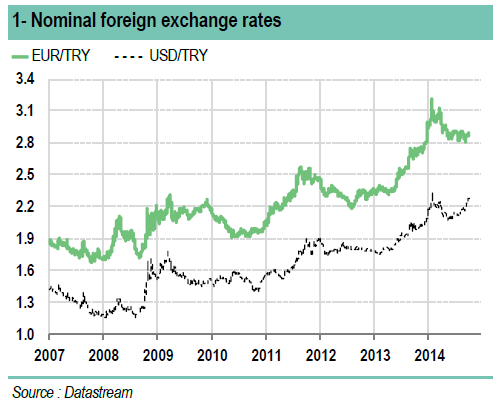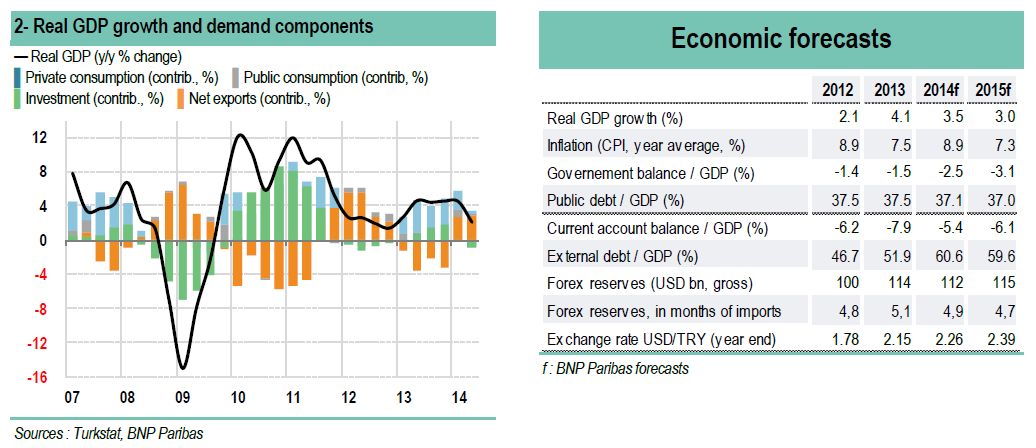(Geo)politics…
Despite fierce headwinds – including social and geopolitical tensions, alleged corruption scandals, high inflation, sluggish consumption and investment, and recent increase in the unemployment rate – the incumbent AKP party unsurprisingly won the presidential elections last August, after sweeping the municipal elections in March. Prime Minister Erdogan became the first president of the Republic of Turkey to be directly elected by popular vote, winning a 52% majority as of the first round. Yet the high level of abstention underscored the fatalism of a secular portion of the population, who reject Mr. Erdogan’s divisive personality but were not convinced by the alternative, the weak opposition incarnated by Mr. Kiliçdaroglu’s CHP party.
While awaiting the next round of legislative elections in June 2015, the markets were reassured by the reappointment of Mr. Babaçan as deputy prime minister and Mr. Simsek as finance minister in the cabinet of the new Prime Minister, Mr. Davutoglu (formerly minister of foreign affairs and the new head of the AKP). Both advocate macroeconomic orthodoxy. Mr. Erdogan is determined to transform the parliamentary system into a presidential regime, and early elections might be called in order to strengthen the AKP’s position (currently 57% of parliamentary seats) before amending the constitution, which requires a qualified two-thirds majority vote. The AKP’s position was not weakened by the open conflict with the Gülen brotherhood, which failed to rally popular support, facilitating the removal of Gulenists from key institutions (ministries, police, and justice departments).
Political noise and lack of visibility are exacerbated by the geopolitical risks arising from the escalating regional conflict in Syria and Iraq. Turkey is now hosting about 1.5 million Syrian refugees on its territory. The recent release of Turkish nationals held by the Islamic State (IS) paves the way for Turkey to join the international coalition. Looking beyond the religious dilemma (the IS and Turkey are both Sunnite), the Kurd issue is a Gordian knot for Turkey’s regional strategy. It is hard for Turkey to imagine participating in an effort to arm Kurdish fighters (Iraqi Peshmergas, Syrian HPG-PYD, and Turkish PKK) fighting in the front line against the IS: this risks strengthening Turkey’s Kurdish community, with whom bitter peace negotiations have been dragging on for years.

… and the vicissitudes of monetary policy have kept the markets on their toes
The Turkish lira (TRY) appreciated 11% against a euro-dollar basket between February and May, after falling 25% between May 2013 and January 2014. Investors were reassured by the CRBT’s emergency response on 28 January, when the central bank redefined its monetary policy framework around the key 1-week repo rate, which was raised from 4.5% to 10%, and reduced the size of FX auctions.
The lira’s appreciation was cut short when the CBRT initiated a new round of monetary easing at the end of May, justified by very favourable global liquidity conditions and the gradual easing of the inflationary pass through of currency depreciation. The CBRT lowered its key rate by 175bp to 8.25% in three successive moves, action that was supported by the economic slowdown observed last spring (see below). Although the key rate has not been changed over the past two months, the marginal overnight lending rate (the ultimate refinancing instrument during bouts of liquidity stress) was cut from 12% to 11.25% in late August. This decision highlights the dilemma facing the monetary authorities, who are caught between a rock and a hard place (political pressures for further monetary easing on the one hand, and macroeconomic imbalances calling for maintaining restrictive monetary conditions on the other).
Monetary policy now seems to be too accommodative. Unfavourable weather conditions, including a harsh winter and a very hot summer, have driven up food prices and headline inflation (to 8.9% in September, compared to an official target of 5%). But core inflation has held above 5% for the past three years (9.3% in September), suggesting that there is problem of structural inflation. Any deflationary efforts will be hampered in the short term by the re-acceleration of lending (consumer credit rose 16% at an annualised, 13-week moving average in September) and the announcement of a 9% increase in electricity and gas prices in October.
Financial market volatility has increased over the past two months against a backdrop of geopolitical tensions and another slump in eurozone activity. The USD/TRY exchange rate dropped 8% vs. a 5% decline for a basket of the main emerging country currencies. The Istanbul stock exchange fell 11% vs. a 6% decline for the MSCI emerging country index. The CDS premium over Eurobonds gained 30bp; the spread with US Treasury bonds, 50bp (vs. 30bp for the EMBI+ composite index); and the interest rate on 2-year Turkish Treasury bonds, 150bp to 9.8%. Under these conditions, the CBRT announced on 26 September that it would raise the minimum amount of its daily currency auctions from USD 10 m to USD 40 m at a time when the overnight interbank money market rate has again crossed the 10% threshold.
■ A policy mix that provides economic support
Economic growth was fairly resilient in H1 2014 at 3.4% year on year, fuelled by exports (+9%) – reinvigorated by renewed competitiveness and a slight rebound in the eurozone – and public spending (+5% y/y in real terms from January to August). In a climate of uncertainty and rising interest rates up until May, real GDP growth nonetheless slowed sharply in Q2 (+2.1% y/y from +4.7% in Q1). Household consumption dropped off sharply (+0.4% y/y from +3.5% in Q1). Investment plunged (-0.9% y/y in Q2) reflecting the decline in equipment and machinery expenditure, while construction continued to rise, bolstered by public investment (+11% y/y over the first eight months).
Macroeconomic adjustments automatically triggered a gradual turnaround in the external accounts, facilitated by lower oil prices. Although financing of the current account deficit (6.1% of GDP over 12 months in July) is still intrinsically weak (low foreign direct invetsment), the rebound in portfolio investment (USD 16.8 bn between April and July) has helped rebuild FX reserves (+USD9.3bn since February).
Monetary easing was coupled with fiscal stimulus due to an electoral platform propitious for spending and a strategy based on major infrastructure projects. At this point, however, the slight budget overrun and increase in the cost of financing do not seem to be very alarming (the primary balance is close to equilibrium; moderate public debt).
Although leading indicators (PMI, confidence indicators, credit) suggest that economic activity will hold up well in the months ahead, real GDP growth is likely to remain below its long-term potential through the end of 2015. This figure has declined for the past three years, from about 4.5% to 3.7%. Coupled with the current climate of uncertainty, this could rekindle efforts to pursue structural reforms (taxation, the job market, education, and productivity).

BY Sylvain BELLEFONTAINE
